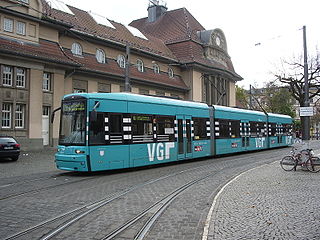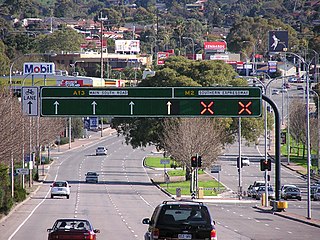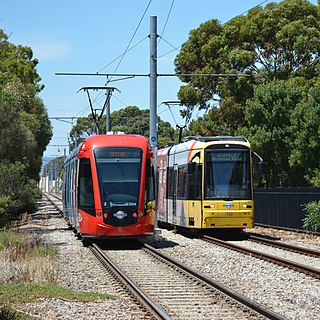
Adelaide Metro is the public transport system of the Adelaide area, around the capital city of South Australia. It is an intermodal system offering an integrated network of bus, tram, and train services throughout the metropolitan area. The network has an annual patronage of 79.9 million, of which 51 million journeys are by bus, 15.6 million by train, and 9.4 million by tram. The system has evolved heavily over the past fifteen years, and patronage increased dramatically during the 2014–15 period, a 5.5 percent increase on the 2013 figures due to electrification of frequented lines.

Goodwood railway station is a commuter railway station and the junction station for the Belair, Seaford and Flinders lines. The Belair line diverges south-east towards Millswood, while the Seaford and Flinders lines diverge south-west towards Clarence Park. The Glenelg tram line crosses over the railway lines at the south end of Goodwood station. The station services the Adelaide inner-southern suburb of Goodwood, and is 5.0 km from Adelaide station.

Melbourne tram route 75 is operated by Yarra Trams on the Melbourne tram network from Vermont South to Central Pier. The 22.8 kilometre route is operated out of Camberwell depot with A and B class trams. It is the longest route on the network.

The Adelaide rail network is a metropolitan suburban rail system serving the city of Adelaide, South Australia, Australia. It consists of 89 railway stations across 7 lines, which served a patronage of 15.6 million people over the year 2018-19. Keolis Downer under contract from the Government of South Australia operates the Adelaide suburban rail system. The operations are set to be handed back to the hands of the public by January 2025.

The Glenelg tram line is a tram/light rail line in Adelaide. Apart from a short street-running section in Glenelg, the line has its own reservation, with minimal interference from road traffic.

The 3000 class and 3100 class are a class of diesel railcars that operate on the Adelaide rail network. Built by Comeng and Clyde Engineering between 1987 and 1996, they entered service under the State Transport Authority before later being operated by TransAdelaide and Adelaide Metro. Trains are typically coupled as multiple units, though the 3000 class are also able to run as single units when needed. In total, 70 railcars were built and are expected to be retired between 2030 and 2032.

The Bombardier Flexity Classic is a model of light-rail tram manufactured by Bombardier Transportation. Although it is marketed as the most traditionally designed member of the Flexity family, it is still a modern bi-directional articulated tram with a low-floor section allowing good accessibility, especially to passengers in wheelchairs. Flexity Classic trams run on 1,435 mmstandard gauge in Australia, 1,000 mmmetre gauge in Essen, 1,450 mm in Dresden, and 1,458 mm in Leipzig.

The Seaford line is a commuter railway line in the city of Adelaide, South Australia. It is the city's second longest metropolitan railway line at 35.9 kilometres (22.3 mi).
South Road and its southern section as Main South Road outside of Adelaide is a major north–south conduit connecting Adelaide and the Fleurieu Peninsula, in South Australia. It is one of Adelaide's most important arterial and bypass roads. As South Road, it is designated part of route A2 within suburban Adelaide. As Main South Road, it is designated part of routes A13 and B23.

The metropolitan area of Adelaide, South Australia is served by a wide variety of transport. Being centrally located on the Australian mainland, it forms a hub for east–west and north–south routes. The road network includes major expressways such as the Southern Expressway, the South Eastern Freeway, the Port River Expressway, the Northern Expressway and the South Road Superway. The city also has a public transport system managed by Adelaide Metro, consisting of a contracted bus system including the O-Bahn Busway, six metropolitan railway lines, and the Glenelg-Adelaide-Hindmarsh Tram. According to a study conducted by the Australian Bureau of Statistics, Adelaide has the highest passenger vehicle travel to work (84%) and the second lowest proportion of people walking to work (2.9%)–something that is being combated by the South Australian government in an effort to increase citizen ridership and use of public transport.

The State Transport Authority (STA) was the government agency which controlled public transport in South Australia between 1974 and 1994.

The Municipal Tramways Trust (MTT) was established by the Government of South Australia in December 1906 to purchase all of the horse-drawn tramways in Adelaide, South Australia. The Trust subsequently also ran petrol and diesel buses and electric trolleybuses. It ceased to exist on 8 December 1975, when its functions were transferred to the State Transport Authority, which also operated Adelaide's suburban train services.

The Adelaide tramway network served much of the inner suburbs and a few outer suburbs of Adelaide, Australia, from 1878 up until the 1950s when the network started to decline. The sole Glenelg light rail line was the only route to survive the closures and has remained in operation ever since. After falling into a state of disrepair and neglect, it underwent major upgrades and extensions in the 2000s with a new tram fleet and major extensions.

The earliest trams in Australia operated in the latter decades of the 19th century, hauled by horses or "steam tram motors". At the turn of the 20th century, propulsion almost universally turned to electrification, although cable trams lingered in Melbourne. In cities and towns that had trams, they were a major part of public transport assets.

The H type Adelaide tram was a class of 30 trams built by A Pengelly & Co, Adelaide in 1929 for use on the newly constructed Glenelg tram line. They remained in regular revenue service until replaced by Bombardier Flexity Classic trams in 2006.

The Tramway Museum, St Kilda is Australia's principal museum of the 19th and 20th century trams of Adelaide, South Australia. It is situated at St Kilda, 24 kilometres north of the centre of Adelaide. It is operated by the Australian Electric Transport Museum (SA) Inc., a not-for-profit volunteer organisation affiliated with the Council of Tramway Museums of Australasia. It is dedicated to the study, conservation and restoration of trams that were used in Adelaide or built there, and likewise with a small bus and trolleybus collection.Trams provide unlimited free rides for visitors on payment of the entrance fee. They operate along a 1.6 kilometres purpose-built track between the museum and a large adventure playground.
This article describes the tram types in Adelaide that have operated for the past 146 years: from early days when they undertook a major share of the public transport task before car ownership was well established; through the 49-year period when only one tram line operated; to the city's 21st-century tramways revival.

This article – one of several about Adelaide’s trams – describes the development of new lines and operation of new trams since 2005. Links to an overview and other articles are in the following panel.
The Goodwood Overpass carries the Glenelg tram line over the Adelaide-Wolseley railway line in Adelaide, Australia.

Glenelg railway station was the terminus of the Glenelg railway line and the Holdfast Bay railway line. It was located in the seaside suburb of Glenelg, South Australia.





























